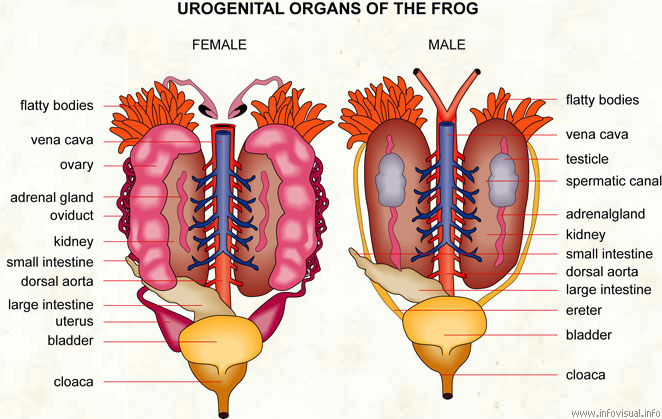What does the reproductive system of a frog do? How is this similar to the human reproductive system?
1 Answer
Reproductive system of frog is responsible for producing gametes which are released in water for fertilisation.
Similarities between human and frog's system are limited to the fact that both possess paired testes/ovary for gamete production.
Explanation:
In both the sexes of frog, each gonad remains attached to the kidney of same side. In human special ligaments attach the gonads to body wall. In males, testes is not abdominal in location; these are present in scrotal sac.
In frogs, testes delivers sperms inside Bidder's canal running through kidney. The sperms exit testes through ureter which is a common urinogenital duct: ureter delivers sperms in cloaca.
In female frogs, ovaries shed the mature eggs in coelomic cavity. Eggs enter oviducal funnel to reach oviduct. Eggs enter cloaca through oviducts of both sides.
In breeding season, frogs perform a false copulation: the act of amplexus so that both the sexes release huge number of gametes together in water. Gametes come out through cloacal aperture.
Frog's larvae are aquatic, gill breathing. Metamorphosis takes place in tadpoles when the frog becomes lung breathing and terrestrial.

https://www.infovisual.info/en/biology-animal/urogenital-organs-of-the-frog
Reproductive system of frog differs from human reproductive system a lot. So I have decided to enlist the differences rather than the similarities.
- Most importantly in male human, ureter is not common urinogenital tract though the urethra is. Sperms from testes travels to urethra along vas deferens.
- In female, there is no common urinogenital tract at all. The two oviducts join to form a triangular organ called uterus, where an embryo can grow.
- Fertilisation in human is internal, takes place inside oviduct (termed fallopian tube). Sperms are transferred directly in female genital tract, through vagina.
- There is no breeding season in human, but there is lunar cyclical period in females. Every month ovulation takes place. Generally only one ovum is released per menstrual cycle.
- Humans are mammals, so females give birth to young ones.
- Accessory reproductive glands are present in human males and females.

